
|
Sale 36
Pre-Long Beach Coin and Currency Auction
| Lot |
Photo |
Description |
Realized |
Lot 3282 |
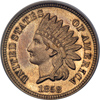 |
1858 Pattern Cent. Copper-nickel, plain edge. . J-208. . P-253. PCGS graded Proof 62. Lightly toned. Pop 17. This is the ever-popular "transitional" issue of the Indian cent with an 1858 date, part of a pattern series (all by James B. Longacre) that includes his large eagle, a small eagle, this Indian head, married to several reverses. Well struck and choice overall, with light hairlines, a few tiny carbon flecks, but nicely formed rims (PCGS # 11885) .
Estimated Value $1,000 - 1,200.
The Emile A. Tartakow Collection.
View details and enlarged photos
Check results on similar lots
| Realized
$1,323 |
Lot 3283 |
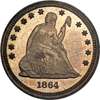 |
1864 Pattern Quarter Dollar. Nickel, reeded edge. . J-389. . P-457. PCGS graded Proof 66 Rarity 8. Pop 1; none finer. PCGS reports only 2, NGC none. Soft satin-like fields careening with lustrous silver-gray and golden color. The design left by the dies lacks a certain robustness due to the hard nickel alloy (the dies were likely set for a more normal, slightly softer copper or silver planchet when this Pattern was made), but that isn't unusual for this rare Judd-389's production. The popular IN GOD WE TRUST reverse as adopted in 1866. Some authorities wonder if these 1863-65 Patterns were actually back-datings made in 1865 or 1866. Be that as it may, the present coin is in sterling condition for such a rare item, one that will fit the needs of just about any specialized collection of the rarer issues (PCGS # 60560) .
Estimated Value $18,000 - 20,000.
View details and enlarged photos
Check results on similar lots
| Realized
$21,275 |
Lot 3284 |
 |
1865 Pattern Dollar. Copper, reeded edge. . J-435. . P-508. PCGS graded Proof 63 Brown Low Rarity 7. Old green holder. Light brown in color with a few minor obverse spots. Copper. Reeded edge. PCGS #4215864. The obverse design is the same that the Mint used for production of regular issue 1865 seated Liberty dollars. The reverse design is the With Motto type introduced in 1866 with IN GOD WE TRUST on a ribbon in the field above the eagle. A very attractive brown toned specimen with a modest golden accents, both sides reveal considerable remnants of proof surface at acute angles. Essentially full in strike, the surfaces also exhibit modest brightness in the fields as the coin rotates under a light. There are no bothersome spots, and only a single little contact mark on Liberty's neck. The color and mirror reflection provides all the eye appeal and technical quality that a collector could ask in a rare Pattern like this. Pop 1; 1 in 64 Brown. (PCGS # 60620) .
Estimated Value $8,000 - 10,000.
View details and enlarged photos
Check results on similar lots
| Unsold |
Lot 3285 |
 |
1866 Pattern Half Eagle. Copper, reeded edge. . J-546. . P-610. PCGS graded Proof 64 Red & Brown. In an old green label holder. Iridescent rose overtones. Pop 2; none higher. Only 2 graded by PCGS, NGC reports none. Impressive looking regular dies trial piece in copper. A blazing crimson to blood-red gem with satiny frosted head of Liberty and intense mirror luster around. Virtually gem quality and one of only 4 specimens in all grades by PCGS. As these numbers show, very few examples of this rare issue in copper were minted. About as fully struck as these are normally found, with just terrific detail in the centers (PCGS # 70744) .
Estimated Value $12,500 - 15,000.
View details and enlarged photos
Check results on similar lots
| Realized
$15,525 |
Lot 3286 |
 |
1867 Pattern Cent. Nickel, plain edge. . J-552. . P-614. PCGS graded AU-58 Rarity 8. In an old green label holder. Pop 1; the only coin graded. Lustrous fields ripple with original mint bloom. Against this are set nicely subdued, matte design elements residing under attractive medium golden brown with accents of silvery gray. Substantial detail to the highpoints on this fine example, although an ineffectual imprint was left in a few areas by the recoil of the dies, possibly due to the hard nickel alloy. The few weak spots include the tips of the upper feathers, ERTY and the end of the ribbon. On the reverse, portions of the lower wreath are also soft around the bow that ties the arrows to the wreath. A deeper toning area at the center as well. Extremely Rare and the only example certified. Judd originally had this piece as Rarity-7, but it has since been advanced by Pollock to Rarity-8, and justifiably so. Obverse and reverse: The dies used to coin regular-issue Proof coins this year. (PCGS # 60762) .
Estimated Value $14,000 - 16,000.
View details and enlarged photos
Check results on similar lots
| Unsold |
Lot 3287 |
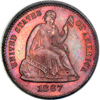 |
1867 Pattern Half Dime. Copper, reeded edge. . J-586. . P-651. PCGS graded Proof 65 Red & Brown. Attractive reddish iridescent toning. Obverse and reverse: The dies used to coin regular-issue Proof coins this year. Bright crimson surfaces make a slow, almost unnoticed change to more subtle lilac purple in areas. All but fully struck, with just a small area of softness on the lower portion of the shield below Liberty's hand. Rare in all grades, this by far the finest graded. Possibly the Finest Known, so bid forcefully or forever regret this day. In an old green label holder. Pop 1. (PCGS # 70798) .
Estimated Value $6,000 - 6,500.
View details and enlarged photos
Check results on similar lots
| Realized
$6,613 |
Lot 3288 |
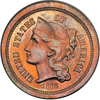 |
1868 Pattern Three Cents. Nickel, plain edge, thick planchet. . J-615. . P-680. PCGS graded Proof 61. A touch of light rose toning. In an old green label holder. Pop 1 with 1 in 64; only 2 graded by PCGS. Are you one of those sophisticated Pattern buyers who like a challenge, someone who goes for the rarest of the rare among these intriguing issues? Then this attractive thick-planchet Judd-615 Pattern is the rarity for you. The toning is quite colorful for a "nickel" based alloy, with warm golds turning to lovely peach-orange hues in places. This, unlike the commoner standard issue of Judd-615, was struck on an extra large planchet that is thicker than normal. It has an extremely broad square rim on the obverse, juxtaposed with a much more normal looking raised rim on the reverse. Unusual to say the least (PCGS # 70827) .
Estimated Value $4,500 - 5,500.
View details and enlarged photos
Check results on similar lots
| Unsold |
Lot 3289 |
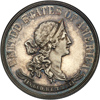 |
1869 Pattern Half Dollar. Silver, reeded edge. . J-748. . P-831. PCGS graded Proof 62 Cameo Rarity 5. Lightly toned on both sides. Nearly fully struck, with just the faintest touch of weakness at the word LIBERTY which, on this STANDARD silver Pattern, is in raised (rather than incuse) letters.
Estimated Value $1,200 - 1,400.
The Emile A. Tartakow Collection.
View details and enlarged photos
| Realized
$1,438 |
Lot 3290 |
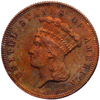 |
1869 Pattern Three Dollars. Copper, reeded edge. . J-772. . P-857. PCGS graded Proof 64 Brown. In an old green label holder. Red wood brown. Pop 1; none higher. Only example reported by PCGS, None reported by NGC. Obverse and reverse: The dies used to coin regular-issue Proof coins this year. And what a spectacular original brown Proof it is, landing right on the knife's edge between the Proof 64 and Proof 65 classifications, and indeed, to all intents and purposes, a gem. The swirling coppery brown surfaces show indications of original faded red color on both sides. The color is irregular but nevertheless gives a presentable appearance for the appreciative viewer.
Nearly every year the Mint produced "regular dies trial pieces" as numismatists refer to them. Whether made to test the dies -- or simply for sale to collectors as profitable novelties -- they are usually in softer metal than the production coin (which seems to point to the former); however, some trial pieces were struck in much harder alloys, and may have been pure pieces d' caprice. Most of these die trial pieces were made in limited numbers. Since these were intended solely to test the dies and there was no consideration give to distributing them to Congressmen so as to influence a decision for a design change, only a small number were made. Judd estimates 4 to 12 known (Rarity-7) for the typical die trial piece. As a consequence, only a small number of collectors can own these wonderful Patterns (PCGS # 61003) .
Estimated Value $25,000 - 27,500.
View details and enlarged photos
Check results on similar lots
| Unsold |
Lot 3291 |
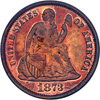 |
1873 Pattern Dime. Copper, reeded edge. . J-1268. . P-1410. PCGS graded Proof 65 Red. In an old green label holder. Warm golden in color. Pop 1; none better. Only example graded. An appealing fresh red specimen of this very rare regular dies trial piece in copper. The coin is fully struck, impressively maintained, and unmarred by spotting or contact marks. Deep crimson red to golden coppery color on both sides. Quite difficult to encounter in this nice a grade in full red, in fact, so rare is the coin that PCGS grades this not only as the finest seen, but also lists no others in the most recent population figures! It is interesting to see, as well, that it was struck from well-prepared dies that imported a sound and in point of fact, a bold design in all areas (PCGS # 81553) .
Estimated Value $15,000 - 17,500.
View details and enlarged photos
Check results on similar lots
| Unsold |
Lot 3292 |
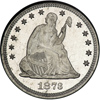 |
1873 Pattern Quarter Dollar. Aluminum, reeded edge. . J-1271. . P-1413. PCGS graded Proof 65. Old green holder. A brilliant gem. Pop 1; only one graded. Obverse and reverse: The dies used to coin regular-issue Proof coins this year. A satiny frosted gem. Graceful underlying luster supports pale aluminum gray iridescence. A pleasing example of the variety, and fully struck, with outstanding detail in the head, stars, and eagle (PCGS # 61556) .
Aluminum was the new "wonder metal" of the mid-1800s when this piece was made. Light and easy to work, it had splendid properties and possibilities. There was only one drawback: price. Although the price of aluminum fell to below that of silver by the early 1860s, it was still expensive to produce, hovering around twelve dollars a pound between 1862 and 1886. It retained this status until metallurgists found a way to smelt it in quantity. As a consequence, the US. mint struck only limited numbers of aluminum patterns and die trial pieces each year, often Rarity-6 or Rarity-7 items. (In 1889, man's technology finally caught up with his need for large quantities of this miracle light metal; prices plummeted and aluminum was soon being used to make tokens, medals, promotional badges, inflation coins by the jillion, and all sorts of other flimsy doodads.
Estimated Value $15,000 - 17,500.
View details and enlarged photos
Check results on similar lots
| Unsold |
Lot 3293 |
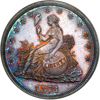 |
1873 Pattern Trade Dollar. Silver, reeded edge. . J-1315. . P-1458. PCGS graded Proof 64. Beautiful natural multi-color toning. Heavenly blue toning at the rim with what seems like a warm golden orange sunrise outlining Liberty on the obverse of this majestic specimen. What eye-candy! What a glorious example of one of the more beautiful Patterns for a Trade dollar. This is the petite figure of Liberty designed by Joseph Bailly. The artist posed his design seated facing left, the right hand supports a liberty cap on a pole and the left rests on a globe inscribed LIBERTY; behind is a wheat sheaf and in front are two bales of cotton on which rests a tobacco plant. For the reverse, it is believed another engraver, not Bailly, used a small eagle standing on a shield with wings raised and beak thrust defiantly forward; three arrows in the left talon and an olive branch in the right. The statutory mottos and legends around.
Joseph Alexis Bailly, who has been chronicled but lightly in the annals of American numismatics, is the putative designer of certain 1873 pattern trade dollar dies and 1874 twenty-cent patterns, following a commission by Mint Director James Pollock, although such dies are not signed by him. An examination of such dies suggests that if Bailly did the work, it only related to the obverse motifs of Miss Liberty, not to the creation of the complete die elements. Pop 12; 1 better in 65. (PCGS # 61601) .
Estimated Value $5,000 - 5,500.
View details and enlarged photos
Check results on similar lots
| Unsold |
Lot 3294 |
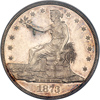 |
1873 Pattern Trade Dollar. Silver, reeded edge. . J-1322. . P-1465. PCGS graded Proof 60 Rarity 4. The obverse on this attractive Pattern issue is similar to the adopted design but has small differences, while the reverse employs a smaller eagle holding a ribbon in its beak inscribed E PLURIBUS UNUM. A nearly fully struck example of this scarce Proof with a light overlay of gray color. Close examination reveals some weakness on the eagle's leg feathers and claws but that is all, everywhere else the strike is bold. Destined for a fine Pattern collection (PCGS # 61608) .
Estimated Value $2,700 - 3,100.
View details and enlarged photos
Check results on similar lots
| Unsold |
Lot 3295 |
 |
1874 Pattern Three Dollars. Copper, reeded edge. . J-1369. . P-1514. NGC graded Proof 66 Brown High Rarity 7. Gorgeous iridescent violet and blue. Pop 1; none better. NGC reports a total of 2, PCGS reports 1 in PR64. Undoubtedly the finest of 2 or 3 known. A bright and gleaming electric blue toned gem whose mirror luster seems poised to detonate like a Fourth of July skyrocket. Plus we find a touch of faint frosted contrast from the head of Liberty as she rises up above in striking relief. This, with the colorful toning, is really pretty. "Adequately struck" does this coin an injustice, since it shows full details on both sides. Definitely an original toned gem!
Note: A "mahogany brown" toned PF66 brown (NGC) example of this rare Pattern sold in a Bowers and Merena sale in July 2004.
Estimated Value $27,000 - 30,000.
View details and enlarged photos
| Realized
$32,200 |
Lot 3296 |
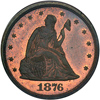 |
1876 Pattern Twenty Cents. Copper, plain edge. . J-1454. . P-1603. PCGS graded Proof 62 Red & Brown Rarity 8. Regular die trial piece. Subdue fiery mint red. 1st generation holder. Pop 1; the only coin graded. As the 1860s closed and the decade of the 1870s unfolded, the number of Pattern die trials began to drift off to the point where only a few were struck each year. 1876 is a case in point. Each of the denominations so issued, the cent, dime, twenty-cent, quarter, and half dollar struck using regular dies, is a Rarity-8 coin, meaning that at most 2 or 3 examples are believed to have been made! This is a sharp looking example of Judd-1454, the twenty-cent denomination. It displays rich deep fire-red hues combined with natural steel brown and purple. The presence of some hairlines precludes a higher grade, but since this is the only example graded, a collector aspiring to own a coin like this had better be prepared to bid (PCGS # 71774) .
Estimated Value $17,000 - 19,000.
View details and enlarged photos
Check results on similar lots
| Realized
$20,125 |
Lot 3297 |
 |
1878 Pattern Dollar. Silver, reeded edge. . J-1554 Rarity 5. . P-1733. Sharpness of Extremely Fine obverse scratches and marks. Lightly toned.
Estimated Value $800 - 1,200.
The Emile A. Tartakow Collection.
View details and enlarged photos
| Realized
$1,320 |
|
|